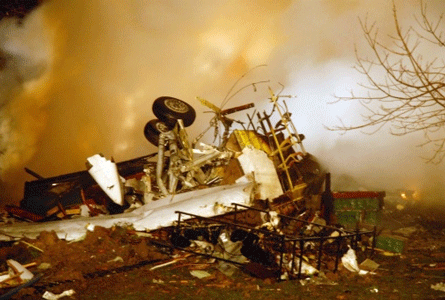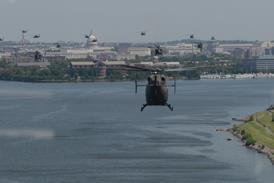With sales of business jets on the increase, Le Bourget will host the strongest line-up of corporate aircraft seen at a Paris air show in recent years. One reason is the growing importance of the international market.
Most attention is focused at the top end of the industry, and in particular on the battle between Bombardier (2/G17) and Gulfstream (chalet 53/A) for the ultra-long-range business-jet market. Bombardier's Global Express will make its international debut at Paris - although not quite as planned. The aircraft which had been destined to attend, 9003, was damaged in a wheels-up landing in April and will not rejoin the flight-test programme until late June, so the Canadian company is bringing the first Global Express, 9001.
Gulfstream, meanwhile, will bring GV number 502, the aircraft with which the company completed a round-the-world tour in April. On that tour, Gulfstream made the first-ever non-stop business-aircraft flights from Los Angeles to London, London to Hong Kong and Tokyo to New York, demonstrating the aircraft's range capability and setting several speed records. Full US certification was received in April, and customer deliveries will begin soon after the show.
Boeing has heightened the competition at the top end of the market by launching a corporate version of its next-generation 737 airliner in a joint venture with engine supplier General Electric. The Boeing Business Jet is a derivative of the 737-700, which will make its air-show debut at Paris. The company has been promising to announce orders which would support its plans to boost production of the 737 business-jet to two a month - the same level planned by rivals Bombardier and Gulfstream. It would be good news for Jet Aviation and K-C Aviation, which have been selected by Boeing as the European and US completion centres, respectively.
Airbus Industrie (2/D18 chalet 139B/B) may choose Paris as the venue to release details of its planned business jet, to be based on the A319 - the smallest member of the A320 twinjet-airliner family.
Dassault (2/A16 chalet 177B/B), meanwhile, has the advantage of being on its home turf, and has its largest-ever business-aircraft range to display, consisting of the Falcon 50EX, Falcon 2000, Falcon 900B and Falcon 900EX. The company anticipates building more corporate jets in 1997 than in any previous year - about five a month - and is studying the business case for developing an aircraft to succeed the mid-sized Falcon 20, now long out of production.
Galaxy creation
Paris will see the international debut of a new company - Galaxy Aerospace (chalet 78/A), formed by Israel Aircraft Industries and the US Pritzker family to market and support the Astra SPX and new Galaxy business jets. The company will display a cabin mock-up of the "super mid-size" Galaxy, and may announce its choice of a US location for its completion and service centre. First flight of the Galaxy is scheduled for the fourth quarter of 1997.
The mid-size market is now the most active sector of the industry, although what constitutes mid-size is difficult to say these days. Dassault pioneered the concept of "super mid-size" with the Falcon 2000; the Galaxy followed, and now Raytheon (chalet 55/A) has launched the Hawker Horizon. Cessna (chalet 31/A), meanwhile, has begun delivering its Mach 0.92 Citation X and continues to produce the Citation VII - both mid-sized aircraft.
The Citation X - awarded this year's US National Aeronautic Association Collier Trophy - headlines Cessna's Paris presence, which includes the latest members of the Citation family, the Bravo and Excel. Deliveries of the Bravo, an update of the Citation II light business jet, began earlier this year, while the Excel is now in flight-testing, with deliveries of the "widebody" light business jet scheduled to begin in the first quarter of 1998.
Bombardier is known to be studying a mid-sized aircraft to fit between its "light" Learjet 45 and "heavy" Canadair Challenger 604, but no announcement on the project is anticipated for Paris. Both of the aforementioned aircraft will be on display, however. The appeal of the new 7,400km (4,000nm)-range 604 boosted the Canadian company to sales of 30 Challengers in 1996, plus three Canadair Special Editions and two Corporate JetLiners - both business-aircraft versions of the Canadair Regional Jet. The Learjet 45, which Bombardier classes as "light-medium" because of its cabin size, is in flight test, with certification expected by mid-year.
Raytheon will have most of its business-aircraft range on display, led by the mid-sized Hawker 800XP, now its flagship aircraft following the decision to end production of the Hawker 1000 and pending development of the Hawker Horizon. The company has now completed the transfer of the Hawker programme from the UK to the USA, with delivery of the last UK-assembled 800XP. British Aerospace will continue to fabricate airframes, however.
Shared attention
Fractional ownership is becoming an increasingly important factor in business aviation, but is still in its infancy outside the USA. Executive Jet, which pioneered the concept in 1986 when it launched the NetJets programme, introduced NetJets Europe in 1996 as a joint venture with Switzerland's Zimex Aviation, with the aircraft operated by Portugal's Air Luxor. There are now five NetJets Citation S/IIs based in Europe, and mid-sized aircraft could be added to the fleet beginning at the end of the year.
This contrasts with Executive Jet's fleet of some 100 NetJets aircraft in the USA, made up of Citation S/IIs, Citation V Ultras, Citation Xs, Hawker 1000s and Gulfstream IV-SPs, with almost 100 more on order - including 20 Citation VIIs and 20 Hawker 800XPs. There are almost 700 fractional owners in the NetJets programme, which allows US owners to use European-based aircraft, and vice-versa.
Executive Jet is far and away the leader in fractional ownership, although Bombardier says that its FlexJet programme is growing steadily. Launched by Bombardier/AMR Combs joint-venture Business JetSolutions in May 1995, the FlexJet shared-ownership scheme has attracted more than 120 customers in two years. There are some 25 Learjet 31As, Learjet 60s and Challengers in the programme already, with more to come, and 25 Learjet 45s plus two Global Express aircraft are on order.
Bowing to the inevitable, perhaps, Raytheon launched a shared-ownership programme for Beech King Airs and Beechjets on the eve of the show. With both the Premier I entry-level and Hawker Horizon mid-size business jets now under development at Raytheon, the potential for fractional ownership of these new aircraft looks strong - either through NetJets or the company-backed scheme. Gulfstream has seen orders for the GIV-SP buoyed by its involvement with the NetJets programme. Executive Jet has so far ordered 30 GIV-SPs, plus two GVs. An order for 11 placed earlier this year boosted the manufacturer to its highest-ever quarterly order intake for the GIV-SP - 21 aircraft - following the sale of a record 44 aircraft in 1996. Dassault has yet to follow competitors Bombardier and Gulfstream into fractional ownership, but says that it is watching developments in the market. Most manufacturers will trumpet plans to improve the worldwide service and support available for their aircraft. Bombardier will open a service centre in Berlin in October, in a joint venture with Lufthansa Technik, which will support European operators of Learjets, Challengers and, from 1998, the Global Express.
Chester centre
Raytheon now has its own European service centre, at Chester in the UK, on the site of the former Hawker assembly line. Cessna, meanwhile, promises news at Paris about plans to establish service centres outside the USA.
Despite the generally rosy picture of the market painted by the manufacturers, the business-aviation industry is not without its challenges. The most recent came in late March when reduced vertical-separation minima (RVSM) rules were introduced on North Atlantic routes. Few business jets have RVSM approval, without which operators wanting to cross the Atlantic cannot use airspace between 33,000ft (10,000m) and 37,000ft. Approvals are available for some Challengers and Falcons, but those for Cessna, Gulfstream, Learjet and Raytheon types are lagging behind.
Another hot topic certain to be aired at Paris is Europe's intention to impose extended-range twin-engined operations (ETOPS) regulations on business jets. Temperatures are likely to be raised by the venue - non-French manufacturers accuse Dassault of promoting the rule, despite evidence which they say proves that no twin-engined business jet has been lost because of engine failure over water. Dassault, which has one twinjet among its predominantly three-engined Falcon range, maintains it is staying neutral on the issue of business-jet ETOPS.
General aviation
It would be unfair to ignore the smaller end of general-aviation (GA), which will be well-represented in the outside park at Paris. On its home ground, Aerospatiale's Socata will display its range of piston-singles, the TB360 Tangara light piston-twin now in flight-test and the single-turboprop TBM700. Avions Robin and Avions Mudry, soon to be sister companies, will add to the Gallic flavour of the GA line-up.
Against this, Cessna, Mooney and New Piper Aircraft will field a strong US presence. Paris will mark the international debut of Cessna's relaunched piston-singles - the 172 Skyhawk, 182 Skylane and 206 Stationair. News on the manufacturer's plans for marketing and supporting the aircraft in Europe and elsewhere is expected at the show. New Piper will be represented by its French distributor, with the display headlined by the updated Seneca V piston-twin, which the US manufacturer believes will appeal to an international market.
Israel's Israviation, although not listed as an exhibitor by the show organiser, reportedly is hoping that the first production prototype of its ST-50 single-turboprop business aircraft will make its international debut at Paris.
Source: Flight International























